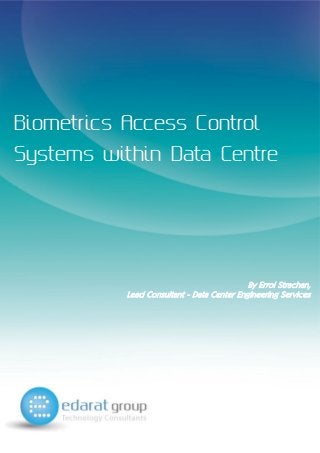
Biometrics access control systems within data centre
- 1. Biometrics Access Control Systems within Data Centre By Errol Strachan, Lead Consultant - Data Center Engineering Services
- 2. For more information about Edarat Group www.edaratgroup.com info@edaratgroup.com Computer equipment must be housed in a secure environ- ment and safeguarded against unauthorised users. One method of ensuring that your Data Centre is secure is the use of biometric security systems. There are various types of biometric systems, however implementation generally requires careful selection to be successful, e.g. it may cause concern to users if they are intrusive and or pose a health risk from transmittable diseases. Biometrics in its various guises has been used for nearly a century. Most people would recognise it from seeing it being used in the context of fingerprints used by the police to identify criminals or to prevent fraud. This attached some negativity to it and possibly the first obstacle will be to change one’s perception of biometrics from one of ‘big brother watching you’ to it being a very sophisticated and safe method of security. Biometrics involves measurable physiological (e.g. finger- print, voice, face or hand geometry) or behavioural charac- teristics (e.g. signature or responses to personal questions etc.) that can be used to verify the identity of an individual automatically. Both systems provide an extra layer of security over smart cards or identification tags, by ensuring that individuals try- ing to access a building or system is actually authorised, and not just someone who has found a lost card or stum- bled across a password. Behavioural type biometrics can be less threatening to users than physiological types which are more intrusive but offer greater accuracy and security. Generally speaking, the less intrusive the biometrics systems, the more readily it is ac- cepted. The security advantages of using biometrics systems are: It eliminates the misuse of lost or stolen cards. Regulates access to security areas. Identifies anyone attempting to gain unauthorised access Biometrics images are irreversible and the process cannot be re-created from the template. The disadvantages are: Capture of biometric information can cause concern amongst users if they feel their rights are being in- fringed upon, e.g. cultural, religious and legal rights. The most common types available for use in Data Centres are: Fingerprint Recognition - has a high accuracy rating, is quick to use, takes up little space, so it’s useful for providing security for a large number of users. Its as- sociation however, with police and criminals, in par- ticular, affects the perception of fingerprint scanning. Facial Recognition – this system is unobtrusive and requires no user interaction so it is ideal for site ac- cess control and monitoring of visitors, it also acts as a deterrent against casual unauthorised access. Three- dimensional systems offer higher accuracy levels and greater flexibility. Retina Recognition - provides high accuracy; however it is extremely intrusive, as it requires the user to place his or her eye close to a camera. This technique in- volves using a low-intensity light source through an optical coupler to scan the patterns of the retina; this may cause serious acceptance problems e.g. health issues due to the process of emitting light into the eye. Iris Recognition - this system is more accurate than either facial, hand or fingerprint technology. The image of the eye including the iris is captured using a digital camera and then analysed using specialist software. Iris scanning is less intrusive than retina scanning be- cause the user is not required to focus on a target, and due to the fact that the camera can capture the image of the eye from a distance. Hand Recognition - involves analysing and measuring the shape of the hand. This system is suitable where there is more user access or where users access the system infrequently and are perhaps less disciplined in their approach to the system. Certain biometrics systems can be intrusive and/or have hygiene implications, such as touching a device that has been handled by a variety of people e.g. in retina recogni- tion, there could be concerns regarding eye infections etc. as it involves placing the eye in extremely close contact to the camera. Regarding user acceptance, facial and iris recognition sys- tems are less intrusive, as pictures taken by a digital camera is a common occurrence, however fingerprint and hand recognition systems are widely used in Data Centres due to costs and they are less problematic compared with the others.
